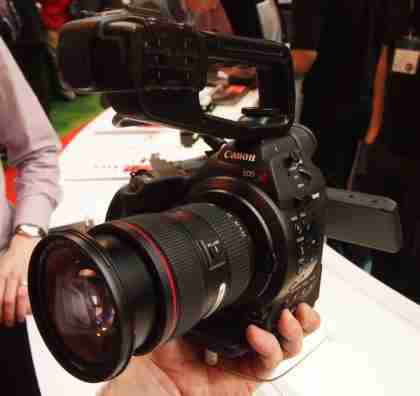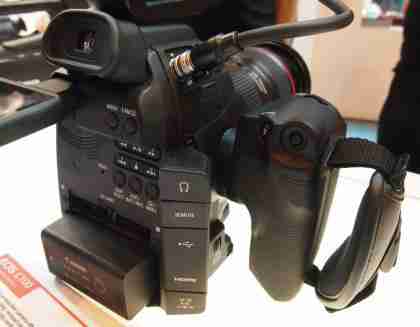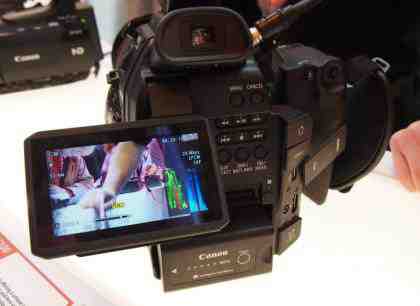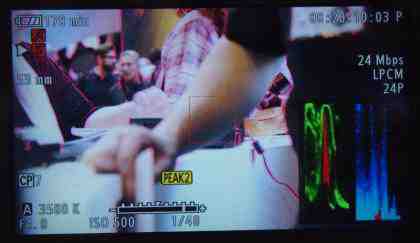Canon C100 review
The Canon C100 is a little beyond our usual consumer scope, as it steps over the line into professional video kit - despite being the cheapest model in Canon's C-range lineup. Still, it's an intriguing device for anyone interested in shooting video and it shows the way forward not just for video recording, but possibly for photography as a whole - as we'll explain later.

It looks a little like a DSLR on steroids but the hardware is purely for video
It became available to buy around three months ago, but with a price of £4,200 plus VAT, it wasn't top of our priority list – though it's now available with 2-years interest free credit if you're tempted. However, having got our hands on one today, and having one of Canon's top guys talk us through the thinking and technology behind it, we thought we'd share our impressions with you.

The handgrip on the right makes it east to manage than its size suggests
The C100 may sound expensive, but it's actually a snip compared to its bigger siblings, most notably the £10,000 C300. It was that device which Canon launched first, and it's a fully-compliant broadcast video camera - by which we mean the quality of its output, combined with the type of video compression used, means you could shoot a whole TV programme on one and the BBC would accept it as being 'HD' quality. The C300 was a big hit with independent producers last year, becoming the most-rented camera in the UK.
The C100 is a cut-down version of that device, though that term hardly does it justice, as it's a very serious piece of kit. It's no DSLR – there's no mirror, no stills, no fully auto shooting mode – but instead a pure-bred video camera, designed solely for shooting Full HD content. It takes any EF lens, giving you a huge choice, including Canon’s EF Cinema Lens lineup, with a crop factor of 1.5x – much like an APS-C sensor.

Loads of manual controls around the back
Its 'Super 35mm' sensor has just eight million effective pixels, and these are grouped into RGGB (Red, green, green, blue) groupings called superpixels. Using this method, the C100 gets rid of the Bayer filter found on most cameras (which provides colour information for the sensor), and instead produces a far more accurate colour image. The smaller pixel count also means hugely reduced noise, yet you still have the two million pixel output required for HD footage. Canon reckons the quality is equivalent to that of a typical 3-chip broadcast TV camera.
AS the C100 is aimed at those who show their work online, or distribute it on Blu-ray or DVD (such as wedding or corporate videographers), it lacks the broadcast-standard compression algorithms of the C300. Instead it outputs in a more enthusiast-friendly H264 at 24Mbit/s to dual SD card slots, allowing for continuous shooting
If you need something higher-quality, though, there is the option to plug a third-party recorder into the HDMI output, which will deliver a clean, uncompressed 4:2:2 video stream, which is broadcast quality and will match up to the likes of the BBC's HD standards. For this purpose a screw hole next to the socket allows you to fit a lockable HDMI lead, to give added security when shooting. XLR connectors on the C100 let you connect high-quality microphones, so audio quality isn't an issue.#

The red fringing lets you know what's in focus
There are some automatic features, to ensure that you get good, crisp footage. A One Shot AF button checks the focus prior to shooting – plus there's red fringing on the LCD display that picks out sharp areas in the frame. A Push Auto Iris button check s exposure and makes any necessary adjustments. There's also manual white balance, so you can shoot quickly without having to fuss about with a bit of cardboard. Canon should even be adding continuous autofocus later this year, which could be handy for some shoots.
